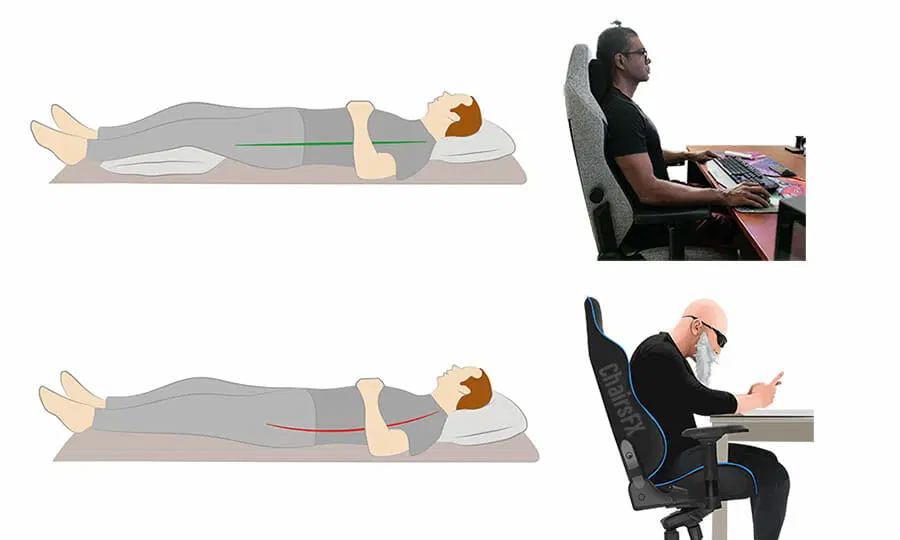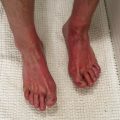Buttock pain can affect both sleeping and seating in several ways. Here are some possible reasons:
- Pressure points: When you sit or lie down, your body weight gets distributed over your buttocks. However, if you have buttock pain, certain areas may become more sensitive to pressure, causing discomfort or even pain. This can make it difficult to find a comfortable position for sleeping or sitting.
- Nerve irritation: Buttock pain can be caused by nerve irritation or compression, such as sciatica. This can cause a radiating pain that affects the lower back, buttocks, and legs. This pain can make it difficult to sit or lie down in a position that does not aggravate the nerve.
- Posture: Poor posture can lead to buttock pain, especially if you sit for long periods of time. When you slouch or hunch forward, you put extra pressure on your lower back and buttocks, which can cause pain. This can also make it difficult to find a comfortable position for sleeping or sitting.
- Inflammation: Inflammation of the muscles, tendons, or joints in the buttocks can cause pain that is worse when you sit or lie down. This can make it difficult to find a comfortable position for sleeping or sitting.
Buttock pain can affect both sleeping and seating by causing discomfort, pain, and difficulty finding a comfortable position.
What is Piriformis Syndrome?
Piriformis syndrome is a neuromuscular disorder that occurs when the piriformis muscle compresses the sciatic nerve, causing pain and other symptoms in the buttocks and legs. The piriformis muscle is a small, pear-shaped muscle that is located deep in the buttock region. Its main function is to help rotate the hip and stabilize the pelvis during walking and other activities.
The piriformis muscle runs diagonally from the sacrum (the triangular bone at the base of the spine) to the hip joint. The sciatic nerve is the largest nerve in the body and runs from the lower back down through the buttocks and legs. In some people, the sciatic nerve passes through or under the piriformis muscle. When the muscle becomes tight or inflamed, it can put pressure on the sciatic nerve, leading to pain, numbness, and tingling in the buttocks and legs.
History
The first description of piriformis syndrome can be traced back to 1928 when Yeoman published a paper describing a syndrome of sciatica caused by the piriformis muscle. However, the condition did not become widely recognized until the 1940s and 1950s when several other researchers reported cases of sciatic pain caused by the piriformis muscle.
One of the most influential researchers in the field of piriformis syndrome was Dr. Guy Voyer, a Canadian osteopath who first described a technique for diagnosing and treating the condition in the 1970s. Dr. Voyer’s technique, called “piriformis syndrome correction,” involves a series of manual manipulations to the piriformis muscle to release tension and reduce pressure on the sciatic nerve.
In the 1980s and 1990s, several studies were conducted to investigate the prevalence and causes of piriformis syndrome. These studies helped to establish piriformis syndrome as a distinct clinical entity and led to the development of new diagnostic and treatment methods.
Today, piriformis syndrome is recognized as a relatively common cause of sciatica and other types of hip and buttock pain. It is estimated to affect between 6% and 36% of the population, with women being more commonly affected than men.
Despite advances in our understanding of the condition, there is still some debate among healthcare professionals about the best methods for diagnosing and treating piriformis syndrome. Some experts advocate for a conservative, non-invasive approach that includes physical therapy and stretching exercises, while others recommend more aggressive treatments such as injection therapy or surgery.
Causes
Piriformis syndrome can be caused by a variety of factors, including:
- Trauma or injury to the buttocks
- Overuse or repetitive strain injury
- Poor posture
- Sitting for long periods of time
- Pregnancy and childbirth
- Anatomic abnormalities
- Tightness or weakness in other muscles
- Arthritis or degenerative changes in the spine
Symptoms
The most common symptom of piriformis syndrome is pain in the buttocks that may radiate down the back of the leg. The pain is often described as a dull ache or sharp, shooting pain. Other symptoms may include:
- Numbness or tingling in the buttocks, thigh, or leg
- Difficulty sitting or standing for prolonged periods
- Pain when walking up stairs or hills
- Pain during or after exercise
- Reduced range of motion in the hip joint
Diagnosis
Diagnosis of piriformis syndrome is often based on a physical exam and a review of the patient’s symptoms and medical history. The doctor may also order imaging tests, such as an X-ray, MRI, or CT scan, to rule out other conditions that may be causing the symptoms.
How To Sit and Sleep With Piriformis Syndrome
If you have Piriformis Syndrome, you may experience pain and discomfort while sitting or sleeping. Here are some tips to help you sit and sleep comfortably:
Sitting
- Sit with proper posture: When sitting, make sure to sit with your back straight, shoulders relaxed, and feet flat on the ground. Avoid slouching or crossing your legs, as this can aggravate the piriformis muscle.
- Use a cushion: If you find it uncomfortable to sit for long periods of time, use a cushion to support your buttocks and relieve pressure on the piriformis muscle. A cushion can help reduce the pressure on the ischial tuberosities (the bony parts of the buttocks), which can help relieve the pain and discomfort associated with Piriformis Syndrome.
- Take frequent breaks: If you need to sit for long periods of time, make sure to take frequent breaks to stand up and stretch. This can help prevent the piriformis muscle from becoming tight and painful.
Sleeping
- Adjust your sleeping position: If you experience pain while sleeping, try sleeping on your side with a pillow between your legs to help align your hips and relieve pressure on the piriformis muscle. This can help prevent the piriformis muscle from becoming compressed and tight during sleep.
- Use a comfortable mattress and pillow: Make sure to use a comfortable mattress and pillow that provide adequate support for your body. A supportive mattress and pillow can help keep your spine in alignment and reduce pressure on the piriformis muscle.
- Stretch before sleeping: Before going to bed, try stretching the piriformis muscle to help relieve tension and reduce pain. The seated figure-four stretch and supine piriformis stretch are good stretches to try.
- Use heat or ice therapy: Applying heat or ice to the affected area can help reduce pain and inflammation. Use a heating pad or ice pack for 15-20 minutes at a time, several times a day. Heat therapy can help relax the muscles and improve circulation, while ice therapy can help reduce inflammation and numb the area.
It’s important to remember that Piriformis Syndrome is a medical condition and should be diagnosed and treated by a healthcare provider. These tips can be helpful for managing the symptoms of Piriformis Syndrome, but they are not a substitute for proper medical treatment. If you experience persistent pain or discomfort, consult with your healthcare provider for proper diagnosis and treatment.





